Marine scientist Dinabandhu Sahoo, along with his team members, has introduced the first artificial reefs in Odisha to combat climate change. The reefs, designed and deployed in coastal waters, aim to enhance fish production, biodiversity, and restore degraded marine ecosystems. Collaborating with civil engineering faculty Sanjukta Sahoo from KIIT University, the team devised unique methods for creating these reefs. Sahoo emphasized that apart from increasing fish production and biodiversity, the artificial reefs would aid in protecting the coast against cyclonic storms by reducing wave action. Notably, artificial reef construction is a thriving industry globally, with countries like the USA, France, Japan, China, Korea, and Australia deploying millions of such reefs to boost their economies.
With Odisha’s extensive coastline of about 480km, Sahoo sees significant potential for further exploration. Specific designs and materials of the artificial reefs are expected to provide habitat for marine species while also facilitating carbon dioxide sequestration, thereby contributing to climate change mitigation efforts. Sanjukta Sahoo highlighted the additional benefits of artificial reefs, including job creation through enhanced fisheries production and prospects for marine ecotourism. The team is also engaged in creating underwater forests through seaweed farming in the Bay of Bengal, with seaweeds capable of sequestering more carbon dioxide than land plants. Furthermore, the deployment of an ‘Indian Seaweeds Wheel’ resembling Ashok Chakra aims to absorb carbon dioxide from coastal waters. Future plans involve designing colorful artificial corals to mimic natural reefs, with the goal of boosting marine ecotourism.
Marine scientist Dinabandhu Sahoo, along with his team members, has introduced the first artificial reefs in Odisha to combat climate change. The reefs, designed and deployed in coastal waters, aim to enhance fish production, biodiversity, and restore degraded marine ecosystems. Collaborating with civil engineering faculty Sanjukta Sahoo from KIIT University, the team devised unique methods for creating these reefs. Sahoo emphasized that apart from increasing fish production and biodiversity, the artificial reefs would aid in protecting the coast against cyclonic storms by reducing wave action. Notably, artificial reef construction is a thriving industry globally, with countries like the USA, France, Japan, China, Korea, and Australia deploying millions of such reefs to boost their economies.
With Odisha’s extensive coastline of about 480km, Sahoo sees significant potential for further exploration. Specific designs and materials of the artificial reefs are expected to provide habitat for marine species while also facilitating carbon dioxide sequestration, thereby contributing to climate change mitigation efforts. Sanjukta Sahoo highlighted the additional benefits of artificial reefs, including job creation through enhanced fisheries production and prospects for marine ecotourism. The team is also engaged in creating underwater forests through seaweed farming in the Bay of Bengal, with seaweeds capable of sequestering more carbon dioxide than land plants. Furthermore, the deployment of an ‘Indian Seaweeds Wheel’ resembling Ashok Chakra aims to absorb carbon dioxide from coastal waters. Future plans involve designing colorful artificial corals to mimic natural reefs, with the goal of boosting marine ecotourism.





